7 vegetables to plant now and enjoy for years to come
Perennial vegetables are like old friends. You nurture them over the years, strengthening your bond, learning to know them on a deeper level. Compared to annuals, which come and go in a season, perennials usually die back in winter and come alive again in spring, although some produce year-round in our area.
Since they are already established, you don’t need to start from scratch with new starter plants or seeds. They take less work and offer a good yield. Enjoy both new and familiar flavors with the following perennial vegetables.
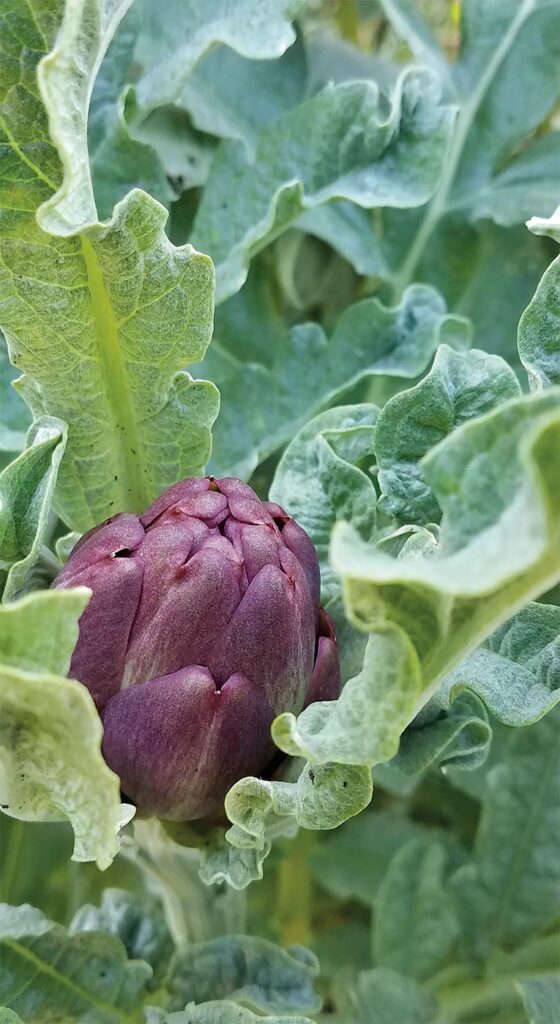
ARTICHOKES
Cynara cardunculus
Two-thirds of the world’s artichokes are grown in Monterey County, and the town of Castroville is known as the “Artichoke Capital of the World.” The rich soil of the Salinas Valley combines with the sandy soil of Monterey Bay, providing the fast-draining soil that the artichoke desires. So growing them in your garden should be a slam-dunk.
The artichoke, considered a superfood, has been eaten for eons for its health benefits. It is low calorie, low carb and high fiber. It is even sold as a supplement or extract, recommended for digestion (including irritable bowel syndrome), and liver and heart health.
It’s also an impressive landscape plant, with large, exotic-looking purple flowers set off by long, arching grey-green foliage. In the ground artichokes can grow up to 6 feet high and 8 feet wide. They also do well in raised beds, but will stay about 4 feet tall. They toss up new little plants that grow into tall flower stalks. Let them spread and multiply, if you have the room.
Plant in at least two feet of good rich soil. Water moderately but regularly. The plants will look brighter and produce more flower heads (the part we eat) if they are fertilized once a month with an organic, balanced, granular fertilizer like E.B. Stone All-Purpose Plant Food, and I also throw a bucket of organic fish/kelp emulsion on the colony. When harvesting, cut back to a node; the branch may regenerate and bear more heads. When stalks get thick and woody, cut them to the ground. I also remove yellowing, spent or buggy leaves, to allow in light and air, which encourages the plant to regenerate and continue to provide thistles for a long, long time.

ASPARAGUS
Asparagus officinalis
Asparagus grows well along the Central Coast. It likes sandy soil—so it is perfect for some mountain gardens. It can even take some salt in the soil and may be suitable for beachside gardens.
“Asparagus is a great crop because it can thrive in areas of your garden that other crops might not,” says Reed Dahlmeier, a high-energy homesteader with a 4-acre, organic farm in Aptos.
“Perhaps I’m biased, but I swear they are substantially sweeter and more succulent when grown at home and eaten fresh. Giving our asparagus a healthy pile of compost once or twice a year has led to our largest, sweetest spears. My favorite way to cook them is to sear them in a little olive oil or toasted sesame oil, then just as they get tender, add a huge pile of minced garlic and a big pinch of salt.”
Asparagus can be weedy, so plant in a raised bed unless you have a large garden where it can ramble. Grow in full sun, in rich, well-drained soil. Harvest asparagus from March to June. As Dahlmeier notes, a thick layer of compost is key. Asparagus takes patience, and you must wait a couple years before harvesting. However, your patch can live for up to 15 years.
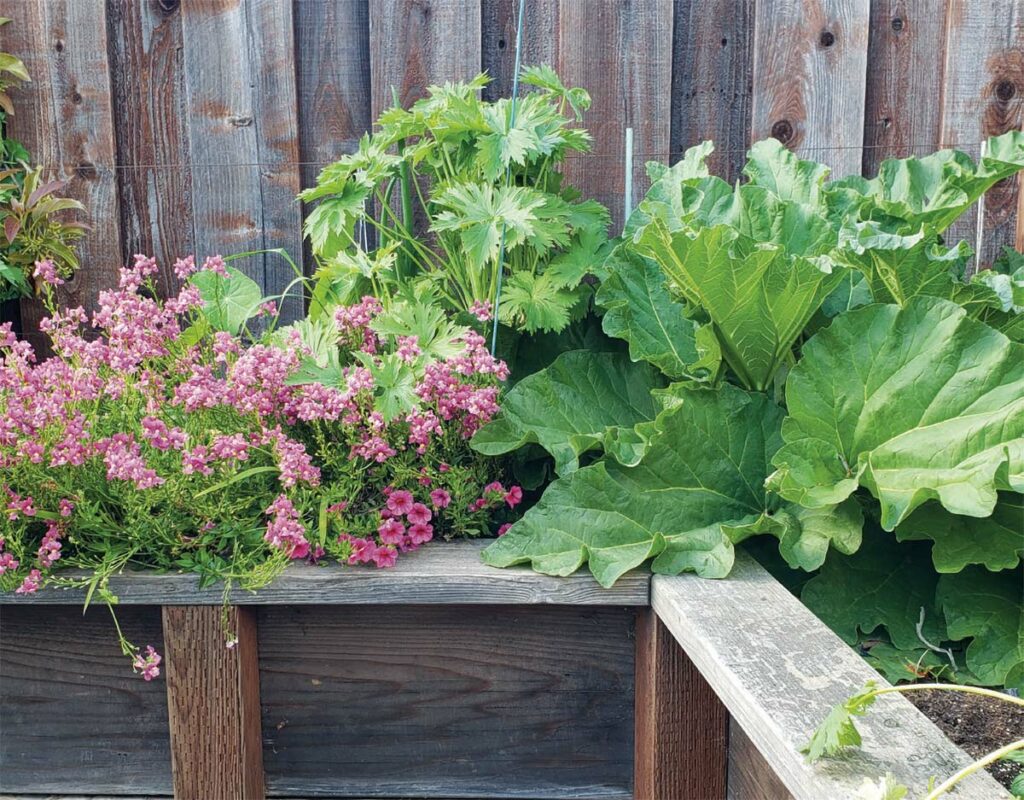
RHUBARB
Rheum rhabarbarum
Rhubarb is famously used in strawberry rhubarb jam or pie, and those who love it can’t get enough of the sweet-tart edge it imparts. I am one of them. It’s hard to turn down a piece of strawberry-rhubarb pie, diet or no diet. Anyway, rhubarb can persist in the garden with neglect, even in full sun and almost no water. It will look like hell, but it probably won’t die! That said, if you want to get a good harvest, it needs a little loving care to produce—weekly watering and occasional fertilizing with fish emulsion won’t hurt. Harvest the stalks when they turn red. Do not eat the leaves, which are poisonous.
This plant has tough roots. Herbalists value the impressive thick whitish root as a demulcent for constipation. (So, if possible, offer your big stalk to an herbalist, if you happen to pull the roots out, instead of putting it in the green bin.)
If it dies back—which it may not in our mild winter climate, especially if it is in a sheltered place—it will come back hardy and strong the next year. Rhubarb likes full sun but can take some shade. Give it at least three feet of space to spread its stalks or it will smother the plants around it. Note that when it flowers, it is bolting. Cut the flowers back if you dare—the flower is curiously strange and beautiful. Although bolting won’t hurt the flavor, cutting it back will result in a bigger harvest. They say a rhubarb patch can last over 100 years!
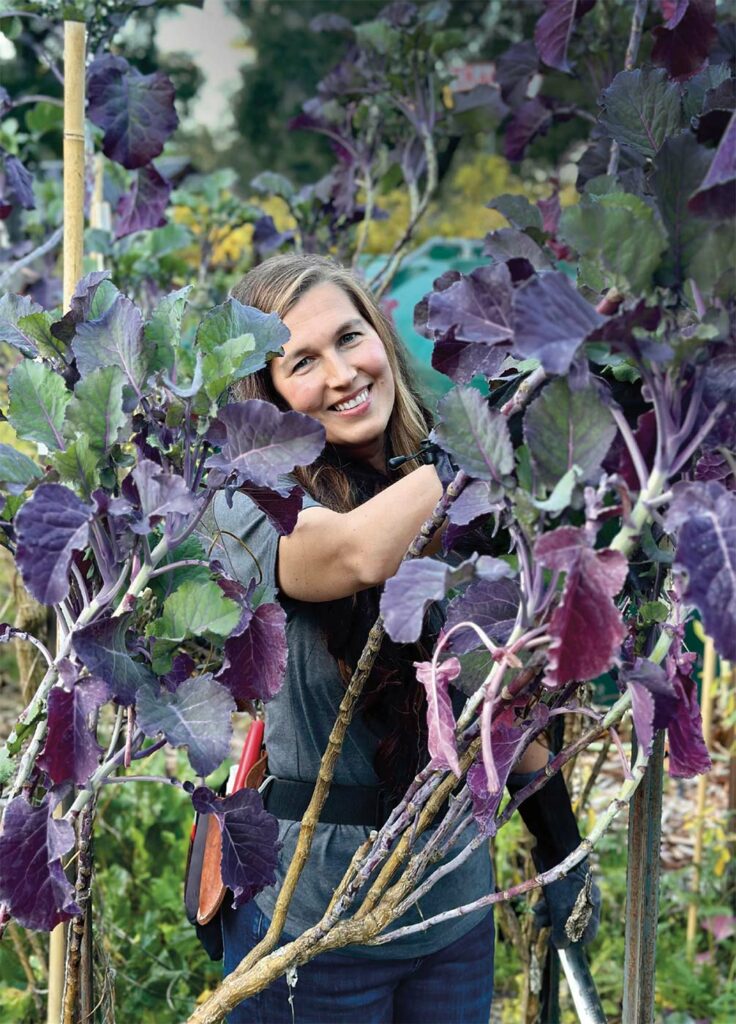
TREE COLLARDS
Brassica oleracea var. viridis
Just about all year round, when you need some greens and nothing else in your garden is producing—and you don’t want to go to the store—tree collards may be your saving grace. The succulent dark green leaves—easy roughage—goes well any way you would use kale, like sautéed, in scrambled eggs or a frittata or as part of a casserole or soup. You can also use the big leaves as a wrap for raw sushi or burritos. And, if you juice, tree collards are a dream plant—a near constant source of dark leafy greens to give you that electric jolt in a Mason jar.
“Perennial tree collards are one of the most generous plants you can grow in the garden,” says holistic chiropractor and permaculture homesteader Christy Garner. “They give so much and ask for so little. In my garden, they produce year-round.”
Garner, who has an expansive homestead in Felton, develops and selects seeds for the tastiest, tallest, most robust and beautiful plants. Her varieties vary between 6 and 10 feet tall. She sells four named varieties that have different growth habits, different shades of light green to purplish leaves and unique if similar flavors, on her website plantonce.com.
Tree collards can grow in a container, but will get larger and stronger in the ground. Plant in full sun to part shade and water weekly. Fertilize lightly with organic fish/kelp emulsion.
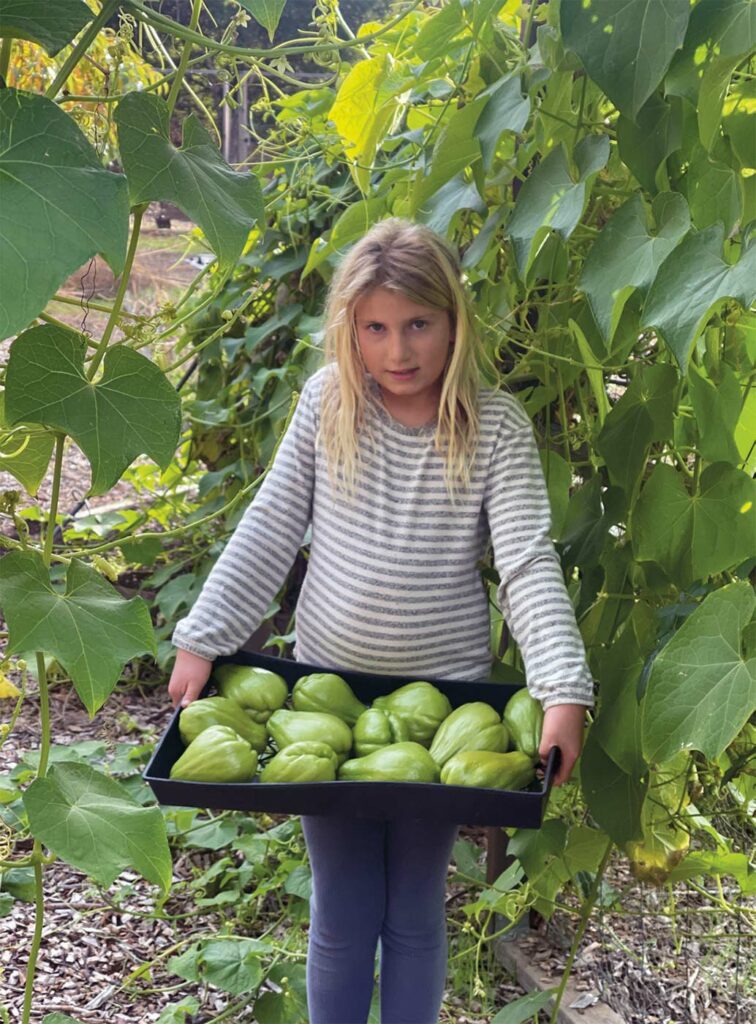
CHAYOTE
Sechium edule
Chayote is a plant for the people. It can feed an army. A vine can grow 30-feet long and produce 50 or more squash fruits from October to January on the Central Coast. It is versatile in the kitchen and tastes something like zucchini…or maybe winter squash. Yet it’s a little crunchy and hydrating, like a cucumber. Indeed, chayote is in the cucurbit family as are zucchini, squash and cukes. And it is also reminiscent of potatoes. It is familiar—and yet not.
A healthy food, it is low glycemic, low calorie, low fat and high fiber. Like nopales (cactus pads), it can help reduce the risk of diabetes and heart disease. Chayote is grown all over the world, but comes to us from Mexico and Central America, where it is a well-loved staple.
“We have eaten them raw, stir fried, steamed and in soups,” says Dahlmeier. “I first came across chayotes in a Oaxacan beef soup recipe that my family and I love, but found the fruit hard to come by in most markets.”
So, he started growing them. They are easy—regular water and compost will do. To grow chayote, he advises, first find one at a grocery store. “You can place the fruit in your windowsill until it sprouts. Then just plant the fruit halfway in the soil with the sprout above the soil.”
Plant it in a sheltered area in full to part sun, next to a trellis, a fence or a tree so it can climb and not get stepped on. The next thing you know it will be shooting up above your head, and you’ll be looking up at squashes. Dahlmeier’s family also makes chayote bread with chocolate chips—similar to zucchini bread.
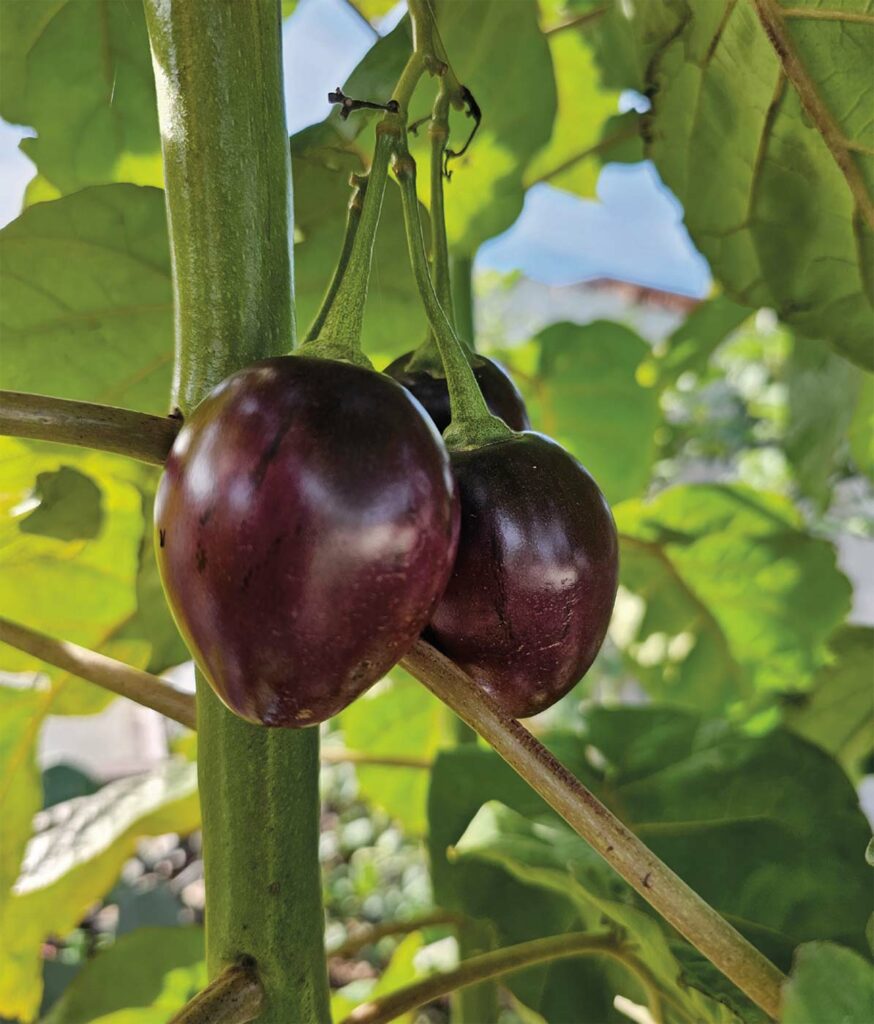
TREE TOMATOES
Solanum betaceum
Tree tomatoes have migrated our way from Central and South America. Also called tamarillos, they are not tomatoes, but they resemble them and are reminiscent of them. The skin feels similar. You would choose the same knife to slice them. When you cut them in half, they have beautiful vibrant flesh that is the same consistency as tomatoes, with their seeds similarly displayed. They come in the same colors as tomatoes—a range of reds, oranges and yellows.
Yet they taste different. The flavor is nuanced—somehow mysterious— often described as tart, sweet and tangy.
This attractive landscape plant has large tropical looking leaves, edged in purple. The pretty whitish flowers turn into beautiful, jewellike hanging fruit. The Central Coast is a perfect place to grow them— they like our mild weather. Tree tomatoes like a sunny but sheltered spot. They grow to around 6 feet tall by 4 feet wide, with weekly water and occasional fertilizer.
Santa Cruz Fruit Growers, a volunteer organization with a fruit jungle at Whiskey Hill Farms in Watsonville, has grown 60 varieties of tree tomatoes in greenhouses there—for fun, and potentially for profit, if they can develop a market for them. Maybe they will, as this is a taste of home for my friends from Guatemala, who literally tear up when they see a tree tomato growing here.
Slawek Wojtowicz of Prunedale, an active member of the group, is an expert on tree tomatoes and other unusual fruits. He wrote “the book” on tree tomatoes, eponymously titled Tamarillos aka Tree Tomatoes.
Explaining their appeal, he says, “Being less common in some parts of the world, they add an exotic touch to dishes and are sought after by culinary enthusiasts looking to try something different.”
In our native foodways garden, my dear friend Emiliano Sanchez bites into tamarillos raw, like garden snacks. Sanchez showed me how his family eats them with eggs in the highlands of Guatemala. They boil them, remove the skin and seeds, mash them and whip them into raw eggs before scrambling or making an omelet. The result is delectable umami-flavored eggs. I also mashed one up and put it in a soup with meaty runner beans, garlic, a sweet red pepper, garden cilantro and Himalayan salt. The taste was magical. The rich broth edged on smokiness. Spices would have been superfluous.
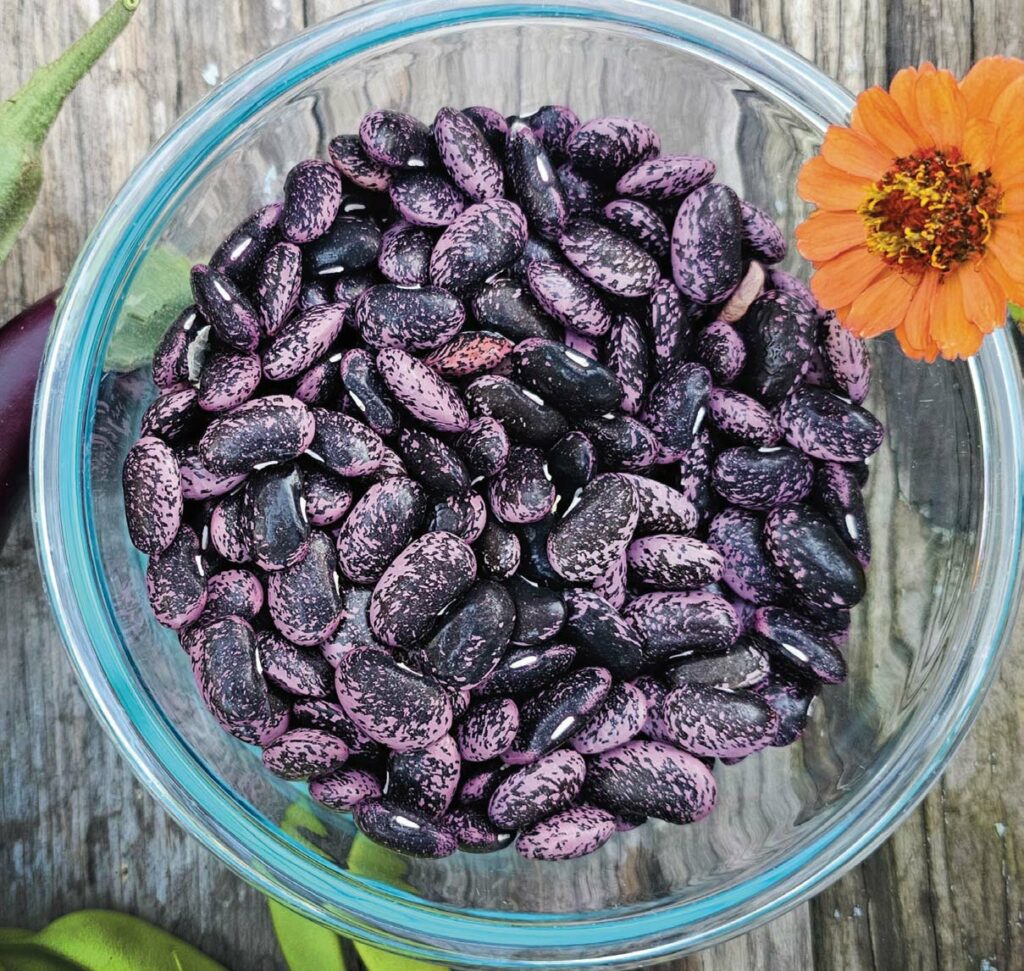
SCARLET RUNNER BEANS
Phaseolus coccineus
With their graceful red flowers, scarlet runner beans are perhaps the most beautiful beans a gardener can grow. Although the pods look leathery, they are yummy green beans in late spring to mid-summer. By late June you can harvest them as fresh snap beans. You can also let them mature into 8-inch-long pods and leave them to dry on the vine. Just be sure to pick them before the rains, so they don’t rot.
Scarlet runner beans are a chef’s favorite. This satiating bean is large and meaty, with a creamy consistency, and holds its shape through cooking. It makes a delicious broth, and is perfect for a hearty soup or chili. Served fresh, the beans will pretty up a salad. (The young beans may be violet.) And so will the flowers, which are edible. The dry beans are shiny and speckled purple and black. However, if you want to eat these beans, you will probably have to grow the plants yourself, as they are rarely available at stores or farmers markets.
Hummingbirds love the plants, hovering over them and drinking nectar. In fact, local seed producer, Renee’s Garden, includes a scarlet runner bean variety called magic beanstalk in its Hummingbird Garden packets. It also sells painted lady, with red and white flowers, and hestia dwarf for containers. Rare Seeds sells the varieties black knight, black coat and sunset. Occasionally you can find them at local nurseries as 4-inch starts, as these beans are getting more popular.
Scarlet runner beans are easy to grow, and prolific. They like full sun, regular water and well-draining soils. Like other pole beans they need supports to climb on, and can grow to 12 feet tall.
MORE INFORMATION
Christy Garner shares a wealth of growing tips and sells off-the- beaten-path seeds and plant starts on her website, where you can also read her book Perma Veggies: Plant Once, Eat Forever. plantonce.com
Reed Dahlmeier is an active community gardener and member of the Monterey Bay Chapter of California Rare Fruit Growers. He propagates and grows many hard-to find plants. Visit him on Instagram @littlebootsandroots or email littlebootsandroots@gmail.com to be added to his mailing list.
Slawek Wojtowicz is the author of the book Tamarillos aka Tree Tomatoes and one of the mad scientists behind the vast fruit jungle at Whiskey Hill Farms in Watsonville. Learn more at santacruzfruitgrowers.com.
About the author
Jillian Steinberger-Foster is a regenerative landscape gardener and designer. She is co-owner of Terra Nova Ecological Landscaping with her husband, contractor Ken Foster. They have a thriving homestead on the Westside of Santa Cruz and three active rescue dogs.
- Jillian Steinberger-Fosterhttps://www.ediblemontereybay.com/author/jlsteinberger/
- Jillian Steinberger-Fosterhttps://www.ediblemontereybay.com/author/jlsteinberger/
- Jillian Steinberger-Fosterhttps://www.ediblemontereybay.com/author/jlsteinberger/
- Jillian Steinberger-Fosterhttps://www.ediblemontereybay.com/author/jlsteinberger/


